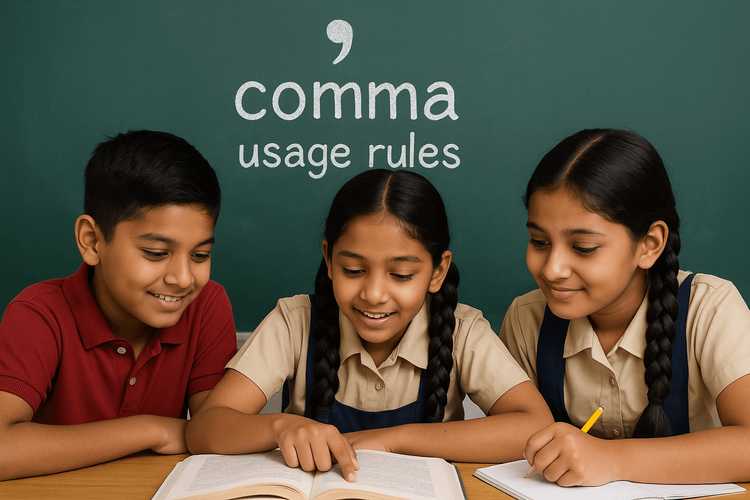Comma Usage Rules in English Grammar with Examples

Table of Contents
- Comma Usage in English Grammar
- What Is a Comma?
- Basic Comma Rules
- Commas with Adjectives and Adverbs
- Commas in Dates, Addresses, and Numbers
- Commas with Direct Speech and Quotations
- Common Comma Mistakes to Avoid
- Tips for Mastering Comma Usage
- Key Takeaways
- Learn More with PlanetSpark – Master Comma Usage
- Conclusion
Proper punctuation is key to clear writing, and the comma plays a crucial role. A correctly placed comma improves readability, separates ideas, and indicates pauses, while misuse can confuse readers. Commas are used in lists, dates, addresses, direct speech, and between clauses, making them versatile in grammar.
This blog covers essential comma rules, common mistakes to avoid, and practical tips, helping students, writers, and professionals master commas to enhance clarity, flow, and overall writing quality.
Comma Usage in English Grammar
The rules of comma usage form the foundation of clear and effective writing. A comma not only separates ideas and adds natural pauses but also prevents misinterpretation in sentences. For instance, the sentence Let’s eat, Grandma has a very different meaning from Let’s eat Grandma. Correct comma usage helps avoid such confusion, ensuring smooth readability.
Writers often use commas in lists, between independent clauses joined by conjunctions, after introductory phrases, and to set off nonessential information. They also appear in dates, addresses, large numbers, and direct speech. Mastering these rules allows students, professionals, and writers to communicate more clearly, making their writing polished and precise.
What Is a Comma?
A comma (,) is a punctuation mark used in English to indicate a pause, separate ideas, or clarify meaning in a sentence. It helps organize sentences, making them easier to read and understand. Commas are one of the most commonly used punctuation marks, yet they are often misused, leading to confusion.
Primary functions of a comma include:
Separating items in a list: e.g., I bought apples, oranges, and bananas.
Dividing independent clauses joined by conjunctions like and, but, or: e.g., I wanted to go for a walk, but it started raining.
Indicating a pause after introductory phrases: e.g., After the meeting, we went for lunch.
Understanding what a comma is and its basic functions lays the foundation for mastering more complex rules. In the next sections, we’ll dive deeper into specific comma usage rules with examples to help you write more clearly and correctly.
Basic Comma Rules
Understanding the basic rules of comma usage is essential for writing clear and well-structured sentences. Here are the most important rules every student should know:
1. Using Commas in Lists
Commas are used to separate three or more items in a list. This helps avoid confusion and ensures that each item is clearly distinguished.
Example: For breakfast, I had eggs, toast, orange juice, and fruit.
2. Separating Independent Clauses with Conjunctions
When two independent clauses are joined by conjunctions like and, but, or, so, a comma is placed before the conjunction. This prevents run-on sentences and makes the sentence easier to read.
Example: I wanted to finish my homework, but my friends invited me out.
3. Commas After Introductory Phrases
Introductory words, phrases, or clauses at the beginning of a sentence are followed by a comma. This separates the introductory element from the main clause.
Example: After the meeting, we went out for lunch.
4. With Nonessential Information
Commas set off nonessential clauses or phrases that provide additional information but are not critical to the sentence’s meaning.
Example: My sister, who loves painting, won an art competition.

Commas with Adjectives and Adverbs
Commas are often used to separate coordinate adjectives, which are two or more adjectives that equally describe a noun. Understanding when to use a comma between adjectives can improve sentence clarity.
Rule: Use a comma between adjectives if you can place the word and between them without changing the meaning.
Example: She is a smart, diligent student. (She is a smart and diligent student.)
When Not to Use a Comma: Do not use a comma between cumulative adjectives where the order matters.
Example: He wore a bright red shirt. (Not bright, red shirt)
Commas with Adverbs:
Adverbs that interrupt or add extra information in a sentence are often set off by commas.
Example: The teacher, clearly impressed, praised the students.
Using commas correctly with adjectives and adverbs ensures sentences are clear, readable, and grammatically correct, enhancing overall writing quality.
Commas in Dates, Addresses, and Numbers
Commas help organize information in dates, addresses, and large numbers, making them easier to read and understand.
1. Dates:
When writing full dates, place a comma between the day and year.
Example: She was born on July 5, 2005, in London.
Also, if the sentence continues after the year, add a comma after the year.
2. Addresses:
Commas separate elements in addresses such as street, city, state, and country.
Example: Send the package to 123 Main Street, Springfield, Illinois, USA.
3. Numbers:
In large numbers, commas make it easier to read and avoid confusion.
Example: The city has a population of 1,250,000.
By using commas correctly in dates, addresses, and numbers, students can improve clarity and precision in their writing, which is especially important in formal and academic contexts.
Commas with Direct Speech and Quotations
Commas play an important role when writing direct speech or quotations. They help separate the spoken words from the rest of the sentence, making the meaning clear.
1. Before Quotation Marks:
Place a comma before the opening quotation mark if it follows a reporting verb.
Example: She said, “I will complete my homework before dinner.”
2. After Quotation Marks:
Commas may also appear after the quotation to continue the sentence.
Example: “I’m excited about the trip,” he added, “but I need to pack first.”
3. Punctuation Inside Quotes:
In American English, commas usually go inside the quotation marks.
Example: “Learning grammar is fun,” the teacher explained.
Proper use of commas in direct speech ensures sentences are readable and grammatically correct, helping students write dialogue and quotations without confusion.

Common Comma Mistakes to Avoid
Even experienced writers often misuse commas. Here are some common mistakes students should avoid:
1. Comma Splices: Using a comma to join two independent clauses without a conjunction is incorrect.
Incorrect: I finished my homework, I went out to play.
Correct: I finished my homework, and I went out to play.
2. Unnecessary Commas: Adding commas where they aren’t needed can disrupt sentence flow.
Incorrect: My favorite colors are, red, blue, and green.
Correct: My favorite colors are red, blue, and green.
3. Omitting Essential Commas: Skipping commas that separate clauses or phrases can make sentences confusing.
Incorrect: After the show we went home.
Correct: After the show, we went home.
Avoiding these mistakes ensures your writing is clear, professional, and easy to read. Regular practice and proofreading can help students master proper comma usage.
Tips for Mastering Comma Usage
Mastering commas takes practice and attention to detail. Here are some effective tips to improve your punctuation skills:
Read Well-Written Texts: Observe how commas are used in books, articles, and newspapers. This helps internalize proper usage naturally.
Proofread Carefully: Always check your writing for missing or unnecessary commas before submitting assignments or articles.
Practice Exercises: Use worksheets and online quizzes to apply comma rules in different contexts. Consistent practice builds confidence.
Understand the Rules: Focus on learning basic rules like using commas in lists, with conjunctions, after introductory phrases, and in direct speech.
Use Grammar Tools: Leverage apps and software that highlight comma errors and suggest corrections.
By following these tips, students can write more clearly, avoid common mistakes, and improve the overall readability of their sentences. Regular practice ensures that comma usage becomes intuitive over time.
Master comma usage and improve your writing. Join PlanetSpark for a free demo class today!
Key Takeaways
Commas are essential for clear, readable, and grammatically correct writing. By following key rules, students can avoid confusion and make their sentences more effective.
Use commas in lists and to separate independent clauses.
Place commas after introductory phrases and around nonessential information.
Use commas correctly with adjectives, adverbs, dates, addresses, numbers, and direct speech.
Avoid common mistakes such as comma splices, unnecessary commas, and missing essential commas.
Practice regularly through reading, exercises, and using grammar tools.
Mastering comma usage not only improves writing quality but also enhances clarity, comprehension, and overall communication skills. Clear punctuation is a vital skill for students, writers, and professionals alike.
Learn More with PlanetSpark – Master Comma Usage
Mastering commas is essential for clear, confident, and professional writing. At PlanetSpark, we make grammar learning engaging and interactive, helping students understand punctuation rules, avoid mistakes, and write with clarity and precision.
Personalized Learning: Tailored lessons guide children through comma usage in lists, clauses, dates, addresses, numbers, and direct speech.
Interactive Sessions: Fun, activity-based classes simplify grammar concepts and make learning punctuation enjoyable.
Focus on English Fluency for Kids: Lessons enhance sentence formation, grammar accuracy, and overall writing fluency.
Practical Worksheets and Activities: Children practice through targeted exercises, real-life examples, and guided corrections.
Expert Mentors: Experienced teachers provide step-by-step guidance in punctuation, grammar, and writing skills.
Flexible Learning: Online sessions allow students to learn from home at their own pace, making grammar learning accessible and stress-free.
Conclusion
Proper comma usage is essential for clear, effective, and professional writing. Understanding and applying rules for lists, independent clauses, adjectives, adverbs, dates, addresses, numbers, and direct speech ensures that your sentences are easy to read and understand.
Students can avoid common mistakes like comma splices, unnecessary commas, and missing essential commas by practicing regularly and proofreading their work. Combining theoretical knowledge with practical exercises improves confidence and writing skills over time.
Platforms like PlanetSpark provide structured learning programs that help students enhance their grammar, punctuation, and overall communication skills. By mastering comma usage alongside guided learning, students can write with clarity, accuracy, and confidence, making their academic and professional work more effective.
Frequently Asked Questions
A comma separates ideas, clauses, or items in a list to improve sentence clarity and readability.
Place a comma between three or more items in a list. Example: I bought apples, oranges, and bananas.
Do not use a comma between cumulative adjectives where the order matters. Example: He wore a bright red shirt.
Commas separate spoken words from the rest of the sentence. Example: She said, “I am ready for the test.”
Yes, improper comma placement can change meaning. Correct usage ensures clarity and prevents confusion.
Common mistakes include comma splices, unnecessary commas, and missing essential commas.
Personalized Communication Report
Record a video to get a AI generated personalized communication report for your child

Hi There, want to try these
tips for your child with
LIVE with our expert coach?
Let's check your child's
English fluency
